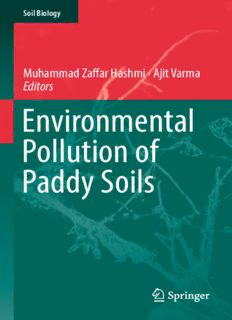Table Of ContentSoil Biology
Muhammad Zaff ar Hashmi · Ajit Varma
Editors
Environmental
Pollution of
Paddy Soils
Soil Biology
Volume 53
Series Editor
Ajit Varma, Amity Institute of Microbial Technology,
Amity University Uttar Pradesh, Noida, UP, India
Moreinformationaboutthisseriesathttp://www.springer.com/series/5138
(cid:129)
Muhammad Zaffar Hashmi Ajit Varma
Editors
Environmental Pollution
of Paddy Soils
Editors
MuhammadZaffarHashmi AjitVarma
DepartmentofMeteorology AmityInstituteofMicrobialTechnology
COMSATSUniversity AmityUniversityUttarPradesh
Islamabad,Pakistan Noida,India
ISSN1613-3382 ISSN2196-4831 (electronic)
SoilBiology
ISBN978-3-319-93670-3 ISBN978-3-319-93671-0 (eBook)
https://doi.org/10.1007/978-3-319-93671-0
LibraryofCongressControlNumber:2018954502
©SpringerInternationalPublishingAG,partofSpringerNature2018
Thisworkissubjecttocopyright.AllrightsarereservedbythePublisher,whetherthewholeorpart
of the material is concerned, specifically the rights of translation, reprinting, reuse of illustrations,
recitation, broadcasting, reproduction on microfilms or in any other physical way, and transmission
or information storage and retrieval, electronic adaptation, computer software, or by similar or
dissimilarmethodologynowknownorhereafterdeveloped.
The use of general descriptive names, registered names, trademarks, service marks, etc. in this
publication does not imply, even in the absence of a specific statement, that such names are exempt
fromtherelevantprotectivelawsandregulationsandthereforefreeforgeneraluse.
The publisher, the authors, and the editorsare safeto assume that the adviceand informationin this
bookarebelievedtobetrueandaccurateatthedateofpublication.Neitherthepublishernortheauthorsor
theeditorsgiveawarranty,expressorimplied,withrespecttothematerialcontainedhereinorforany
errorsoromissionsthatmayhavebeenmade.Thepublisherremainsneutralwithregardtojurisdictional
claimsinpublishedmapsandinstitutionalaffiliations.
ThisSpringerimprintispublishedbytheregisteredcompanySpringerNatureSwitzerlandAG
Theregisteredcompanyaddressis:Gewerbestrasse11,6330Cham,Switzerland
Foreword
Paddy soils are flooded parcels of arable land used for growing semi-aquatic rice.
Rice, a staple food for about one-half of the world’s population, is grown under
lowlandanduplandecosystems.Aslowlandricecontributes~76%oftheglobalrice
production,vasttractsofpaddysoilsexistaroundtheworld.Paddysoils’anaerobic
environmentbringsseveralchemicalchangesintherhizosphere,predominantbeing
changes in redox potential (Eh) and pH; Eh has an impact on redox-sensitive
constituents, like oxygen (O ), iron (Fe), manganese (Mn), nitrogen (N), sulfur
2
(S), and carbon (C). Exclusion of O from the paddy soil environment leads to
2
increaseofcarbondioxide(CO );reductionofCO tomethane(CH );reductionof
2 2 4
(cid:1) (cid:1)
nitrate (NO ) and nitrogen dioxide (NO ) to dinitrogen (N ) and nitrous oxide
3 2 2
(N O); reduction of sulfate (SO 2(cid:1)) to sulfide (S2(cid:1)); solubility enhancement of
2 4
phosphorus (P), calcium (Ca), magnesium (Mg), Fe, Mn, molybdenum (Mo), and
silicon (Si); anddecreaseinplantavailability ofzinc (Zn), copper (Cu), and sulfur
(S). The magnitude of such changes is determined by soil type and status of soil
organicmatter,soilnutrients,andmicrobialactivities.
Environmentally,anaerobicsoilsmayhavebothpositiveandnegativeattributes.
Apredominantnegativeaspectisthatpaddysoilsareoneoftheprimarysourcesof
CH , a potent greenhouse gas; ~25% of CH emitted to the atmosphere is derived
4 4
fromwetlands.Alternatively,anaerobicsoilsalso functionassinks,sources,trans-
formersofnutrientsandcontaminants,andimproversofwaterquality.Thegravity
ofpaddysoils’pollution,causedbynaturalprocessesandanthropogenicactivities,
hasbeenrealizedrelativelyrecently.Thisenvironmentalpollutionnotonlydegrades
soil quality and productivity but also has an adverse impact on human well-being.
Environmentalpollutionofpaddysoilsisaglobalproblem,negativelyaffectingthe
livelihoodandfoodsecurityofbillionsofpeople.Therefore,theneedforenhancing
understandingandawarenessabouttheproblem,itsconsequencesoncropproduc-
tivity and human well-being, and adoption of stakeholder-friendly effective reme-
diation/bioremediationmeasurescannotbeoveremphasized.
This monograph is a comprehensive compilation of state-of-the-art R&D infor-
mationonthesubjectbyleadingexpertsfromaroundtheworld.Itsextensivelistof
v
vi Foreword
chapters encompasses almost all aspects on the subject, i.e., nature, extent, and
gravity of organic (like pesticide residues, antibiotics) and inorganic (i.e., heavy
metals, likearsenic)pollutants, environmental impact ofpollutants onpaddysoils’
chemistry, microbial diversity, enzymatic activity and crop produce quality, toler-
ancemechanismsofriceplanttopollutants,andremediationandbioremediationof
contaminatedpaddysoils.Thus,thismonographwillbeawelcomeadditiontothe
literatureonthesubject.Icommendthechapterauthorsaswellastheeditorfortheir
hardworkandzealinmakingthisvaluablecontribution.
Islamabad,Pakistan AbdulRashid
09April2018
Preface
The term paddy soils has been used for soils on which irrigated rice is cultivated.
Paddy soils make up the largest anthropogenic wetlands on earth and are an
important agricultural ecosystem. They may originate from any type of soil in
pedological terms but are highly modified by anthropogenic activities. The forma-
tionoftheseanthrosolsisinducedbytillingthewetsoil(puddling)andtheflooding
anddrainageregimeassociated withthedevelopment ofaplough panandspecific
redoximorphicfeatures.Theoriginofpaddyricecultivationislocatedsomewherein
thesoutheasternpartofAsiaandissaidtodatebackatleast7000years.Sincethat
time,thedistributionofpaddyricecultivationhasbeengreatlyexpanded,buteven
todayitisbasicallyconfinedtomonsoonAsia,nearitsplaceoforigin.Paddysoils
have developed their own special morphologies, physicochemical properties, and
biologicalcharacteristicswithannualirrigation,cultivation,andfertilization,which
significantlyaffectironredoxcycling.Theperiodicvariationoftheredoxpotential
(Eh) is one of the unique characteristics of paddy soils. The pH variation due to
alternation between wetting and drying is another unique characteristic of paddy
soils. Over the past few years, work on paddy soils has mostly been confined to
microbiology and concerns about greenhouse gas emissions. Geochemical proper-
ties,suchastheamountanddegradabilityoforganicmatter(OM)orironminerals,
affectmicrobialactivities.Conversely,microbesaffectnotonlytheturnoveroftheir
primarysubstrates,butalsopH,redoxpotentials,complexationofmetals,andsolid-
phasechemistrybymodulatingadsorption/desorptionanddissolution/precipitation.
Recently, pollution of paddy soils through natural processes and anthropogenic
activitieshasbeennoted.Paddysoilecosystemsarehighlyvaluableastheyprovide
services (food, nutrient cycling, water relations, etc.) and are linked directly and
indirectly with human health. Chemical contamination of paddy soil not only
degrades the soil services/quality but also has an impact on human health. Never-
theless,foodsafetyissuesandadversehealthrisksmakethisoneofthemostserious
environmentalissues.
The overarching theme ofthis book isto summarizethe currentstate of knowl-
edgeofpaddysoil/ecosystemcontamination.Thebookcoversawiderangeoftopics
vii
viii Preface
forunderstandingtheheavymetals,organicpollutantssuchasantibioticsandARGs
inpaddysoils,theirrisktothepaddyenvironment,andoptionsforeffectivecontrol.
Severalphysical,chemical,andbiologicalremediationmethodshavebeenpracticed
sofartotreatsuchcontaminatedpaddysoils.Enzymaticbioremediationevolvesas
aneffective,low-cost,andeco-friendlytechniquewhichcanbeappliedinthiscase.
This book discusses the types of bioremediation which have been used so far, and
furthermore, enzymatic degradation of contaminants present in soil has been
reviewed. We also discuss the enzymes from various microbial and plant sources
whicharebeingusedforremediationofcontaminatedpaddysoils.Itpresentssome
very important tools and methodologies that can be used to address organic and
inorganicpollutioninaconsistent,efficient,andcost-effectivemanner.Further,the
book includes major types of pollutants in contaminated paddy soils, the routes of
entry and fate of pollutants, biomonitoring approaches, problems and prospects of
cultivating indigenous flood and brackish water-resistant varieties of paddy soils,
anthropogenicimpactofpolymetallichydrothermalextractionsonsoils,riskassess-
ment,theimpactofpaddysoilchemicalsonthesoilmicrobialcommunityandother
biota, bioremediation and biodegradation approaches, as well as contaminated soil
managementstrategies.Weinviteyoutogainabroaderinsightregardingtheroleof
contaminated paddy soils in climate change, impact on crop quality, and arsenic
biotransformation mechanisms in paddy soils through the presentations of our
contributingauthorsinthisbook.
Mostchaptersinthebookarewrittentoafairlyadvancedlevelandshouldbeof
interesttothegraduatestudentandpracticingscientist.Wealsohopethatthesubject
matter treated will be of interest to people outside paddy fields, soils, biology,
chemistry, and agriculture and to scientists in industry as well as government and
regulatorybodies.
Islamabad,Pakistan MuhammadZaffarHashmi
Noida,UttarPradesh,India AjitVarma
Objectives of the Book
The paddy field is a unique agroecosystem and provides services such as food,
nutrient recycle, and diverse habitats. Chemical contamination of paddy soils has
degraded this important ecosystem quality. This book provides our current under-
standingofpaddysoilpollution.Topicspresentedincludemajortypesofpollutants
in contaminated paddy soil ecosystem, factors affecting the fate of pollutants in
paddysoil,biomonitoringapproachestoassessthecontaminatedpaddysoilhealth,
and theimpact of chemicals on soilmicrobial diversity andclimate change. It also
discussesarsenicandheavymetalpollutionofpaddysoilsandtheirimpactonrice
quality. Further, new emerging contaminants such as antibiotics and antibiotics
resistance genes (ARGs) in paddy soil and their impact on environmental health
arealsodiscussed.Thelastchaptersfocusonthebioremediationapproachesforthe
managementofpaddysoils.
ix
Description:The paddy field is a unique agro-ecosystem and provides services such as food, nutrient recycling and diverse habitats. However, chemical contamination of paddy soils has degraded the quality of this important ecosystem.This book provides an overview of our current understanding of paddy soil pollut

